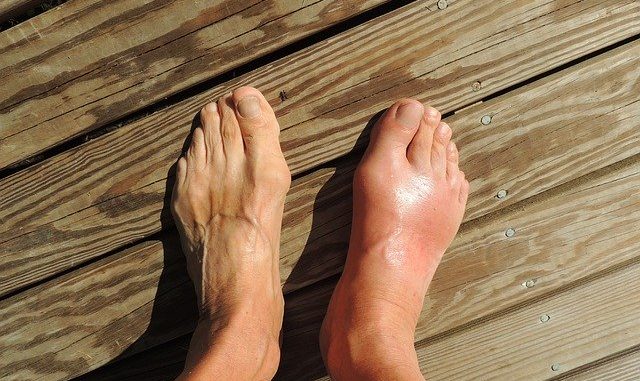
Gout is a particular type of inflammatory arthritis which affects the joints. It is usually just one joint that is affected although the surrounding tissues are also affected too. Severe gout occurs when more than one joint is affected.
The condition is caused by the deposition of uric acid crystals in the joint. Diet and genetic factors have their part to play. Uric acid levels rise to a point in the blood where it cannot be removed effectively and exceeds its crystallization point. This condition is known medically as hyperuricemia. When our bodies break down purines, they produce uric acid.
The symptoms usually occur at night. It appears as swelling, tenderness, redness and sharpness in the joint. It is quite severe and reflects the severity of the joint’s level of inflammation.
Men are more prone to gout than women but postmenopausal women are more prone to gout.
High uric acid levels in the blood are not a problem in themselves and not everyone who has an excessively high level of uric acid leads to gout. Your chances of getting gout is increased by being overweight, drinking lots of alcohol and eating too much protein as with meat, fish, high protein drinks and even lots of vegetable protein.
Some treatments for various diseases such as cancer or excessive muscle damage through rigorous sport can increase your risk of gout. When cells die, high levels of uric acid are released which leads to a rise in the blood.
Gout often appears in the joints at the extremities of the body such as the big toe or occasionally the joints of the fingers. If the flare-up is mild and infrequent, changes to diet and lifestyle suffice otherwise drug intervention is needed.
There are 4 stages of gout/elevated uric acid levels:
1.Asymptomatic hyperuricemia
This is the stage when there are no symptoms of hyperuricemia. The levels of uric acid can be elevated in the body but they do not show any outward symptoms.
2.Acute gout
This stage occurs when the urate crystals that have been formed in the body due to elevated uric levels cause sudden pain and inflammation. This sudden attack is referred to as a ‘flare’ and usually takes three to 10 days to subside.
3. Interval gout
Known as interval or intercritical gout, this condition refers to when the attacks of gout occur after long periods of time. Flares may take years to occur again and can get severe over time. In between two flares, urate crystals are getting deposited in the tissue. If they are left untreated, they can last very long and can begin occurring more frequently.
4.Chronic tophaceous gout
Tophi refers to big lumps of urate crystals. When a patient reaches the stage of chronic tophaceous gout, these big crystals are anywhere in the body, including areas with soft tissues and in one’s joints in the cooler areas of the body, such as in the fingers and elbows. This stage is the most critical and final stage of gout. It is debilitating and is extremely painful. It only occurs when gout may be left untreated for eight to ten years. So, it is highly unlikely to reach this stage if a patient is following proper treatment.
Treatments
Changes made to diet and lifestyle.
- Take more exercise and have a balanced diet
- Eat less protein generally. Some sports people use high protein supplements or certain diets rely on high protein-low carbohydrate to make body shape changes. Reduce the intake of meat, fish and alcohol.
- Reduce the intake of dairy products and replace with low fat-dairy products.
- Reduce weight as obesity is heavily associated with the creation of gout.
Food To Avoid With Gout
Foods that contain high levels of purines need to be avoided because they trigger painful bouts and flare-ups. The body breaks down purines into uric acid.
Typical high-purine foods include:
Red Meat – the worst of all the foods in most physicians eyes. Henry VIII in the English Tudor period for example consumed vast quantities of red meat including beef and pork which supposedly triggered bouts.
Shellfish – Most shellfish are rich in purines so avoid shrimps, prawns and lobster. The little anchovies which is actually a true fish is also associated with flare-up of gout.
Leave a Reply